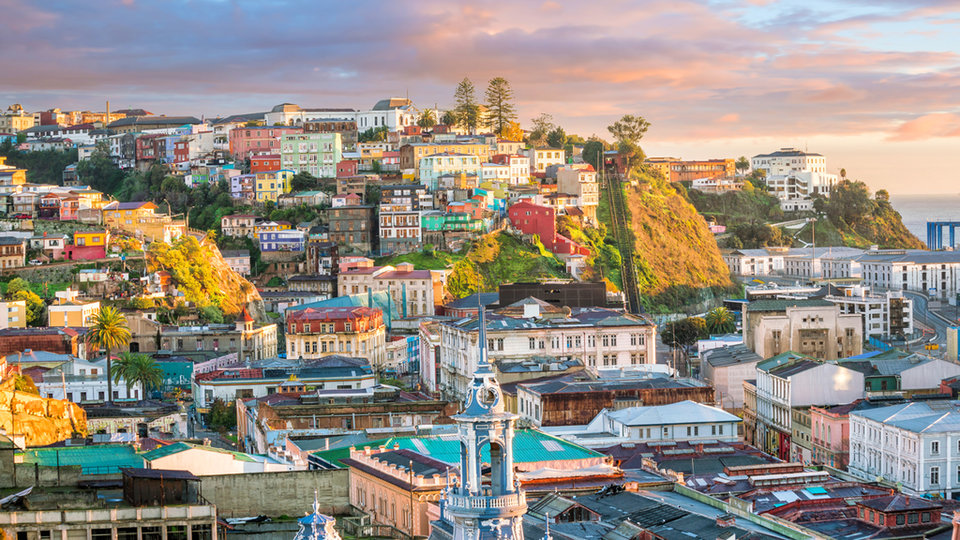Chile’s railway system remains underdeveloped
A much-needed investment
Despite faring better than many of its South American neighbours, Chile’s almost 7.5km-long rail network has been in steady decline over the past few years.
The country ranked 70th out of 103 for quality of railroad infrastructure in the 2019 World Economic Forum’s Global Competitiveness Report, and reached the 61st place for the efficiency of train services. These results may seem positive if compared to the likes of Argentina and Brazil, but in the broader picture, they position Chile far behind major rail markets like Japan and Germany.
“Chile’s railway system remains underdeveloped,” explains Global Data economist Dariana Tani, who is specialised in infrastructure projects in the Americas. “Much of the serving infrastructure is deemed inadequate.”

A cargo train in Santiago, Chile. Image: Cristian Silva Villalobos | Shutterstock.com
The fact that most trains are used for freight rather than passenger operations (much like in the rest of South America) has long been another cause of concern for the government, which in its previous mandate had already managed to double ridership from 25 to 50 million people.
With its ongoing social crisis looking far from resolved, and Chile at risk of sliding even further down the rankings, Tani says the Chile on Rails strategy could not be coming at a better time.
“As the economy is weakening and the country is losing ground in terms of competitiveness and overall quality of infrastructure against its major trading peers,” she continues, “it is reasonable to say that the government is trying to reverse this trend by investing more in critical infrastructures such as railways, roads, airports, energy, water and telecommunications.”
Breaking down the Chile on Rails plan
With its completion scheduled before the end of Piñera’s term, Chile on Rails will look at bolstering passenger and freight services both in Santiago and in the provinces.
Of the $5bn set aside for it, about 44% will be used for projects in the capital, with the remaining 56% being split among regional works, covering a total of 1,000km of rail lines and doubling cargo volumes to over 21 million a year.
One of the most significant projects within the strategy was introduced during September’s launch, when President Piñera made a symbolic trip between Santiago’s Central Station and Melipilla, southwest of the capital. This project will see the construction of 61km of tracks between the two cities, cutting travel time by two hours for the 50 million people it will serve.

Valparaíso (pictured) and Santiago could be are set to be connected by a new rail line.
Other initiatives include a rail link between the capital and its Arturo Merino Benitez Airport, which currently handles 30 million passengers annually, and the construction of the Santiago-Batuco-Tiltil commuter line that will connect six districts, carrying over 17 million people per year.
However, the most crucial project will be the Santiago-San Antonio-Valparaíso line, which will triangulate cargo and passenger connections between the countryside and the sea. As Tani explains: “The rail line that will connect them will facilitate travel between the country’s two largest cities [Santiago and Valparaíso], bolster regional integration and help boost exports from Chile’s Pacific coastline.”
The Santiago-San Antonio-Valparaíso line will triangulate cargo and passenger connections between the countryside and the sea
If protests do not escalate, we’ll definitely see an improvement in ranking in terms of the quality of rail infrastructure
The global consequences of Santiago’s strikes
With works set to begin in 2020, the stakes are high for the government’s plan to succeed, though such success is tied to a number of internal and external factors.
On a national scale, Chile is only waking up to the damage caused by a series of strikes in the autumn of 2019, which led to a drop in gross domestic product (GDP) by 3.5%. Initially triggered by a proposed increase in metro fares in Santiago, they quickly escalated outside the capital, shedding light on the country’s rising inequality issues.

Protestors in Santiago, Chile in October 2019. Image: Pablo Rogat / Shutterstock.com
In December 2019, the Chilean Chamber of Construction (CChC) carried out a survey to assess the impacts the social crisis had on the construction sector. “Delays in project execution, lower sales, cancellation of future contracts and job cuts were among the most relevant factors that affected the industry during the protests,” explains Tani.
Although almost half of the survey's respondents declared the October’s protests had impacted current projects, only 34% are fearing they could damage the success of future and upcoming schemes. As such, “If protests do not escalate,” she continues, “we’ll definitely see an improvement in ranking in terms of the quality of rail infrastructure and the efficiency of train services.”
In addition, the protests failed to discourage Chile’s biggest trading partner, China. According to Tani, Beijing is increasingly eager to support the realisation of the Santiago-San Antonio-Valparaíso line.
This will be responsible for carrying copper and agricultural products to the port of San Antonio, “with China as a top potential export destination,” she says. “For this reason, China is heavily invested in seeing the project move forward.”
Moving towards carbon neutrality and improved competitiveness
Beyond bidding to re-establish trust in the government and improve trade, Piñera’s plan will also be key to boosting the country’s sustainability credentials.
“The government continues to take measures to raise both public and private investment in renewables to make Chile carbon neutral by 2050,” explains Tani, adding that over $6bn have already been devoted to the construction of renewable power plans, with improving rail transport representing a key step in this direction.
“Given how underdeveloped Chile’s railway network is at present and how poor is the efficiency of its train services,” she concludes, “the recently launched rail programme can be seen as important steps the government is taking to address the country’s infrastructure bottlenecks and raise its global competitiveness.”
The government continues to take measures to raise both public and private investment in renewables